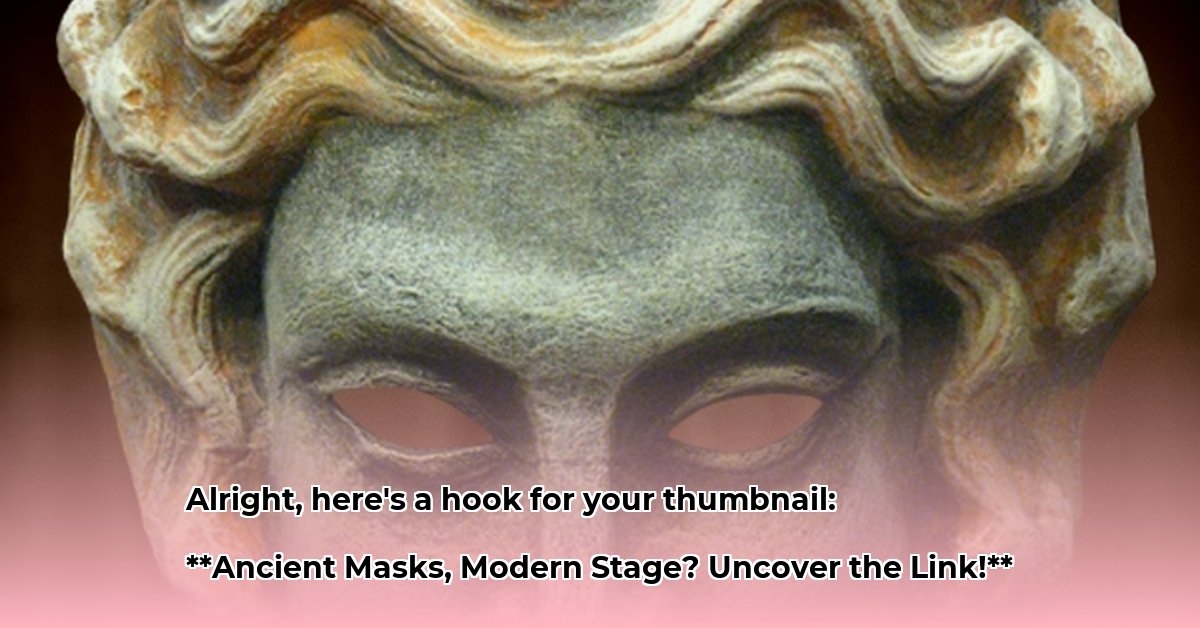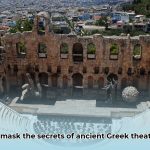Imagine a vast, open-air amphitheater, brimming with thousands of spectators, and a single actor on stage. How did this lone figure command attention, convey complex emotions, and embody diverse characters without the aid of modern technology? The answer lies at the heart of ancient Greek drama: ancient Greek theater masks. Far more than mere facial coverings, these ingenious creations were transformative instruments, intrinsically linked to religious festivals honoring Dionysus, and foundational to the very essence of early Western theater. They shaped vocal projection, enabled profound character portrayal, and held secrets about the sophisticated acoustics of the ancient world that continue to fascinate scholars today. Some sources further explain the nuances of Greek Theater. They shaped vocal projection, enabled profound character portrayal, and held secrets about the sophisticated acoustics of the ancient world that continue to fascinate scholars today.
The Genesis of Greek Theater and the Ritualistic Power of the Mask
The origins of Greek theater are deeply embedded in the religious festivals dedicated to Dionysus, the god of wine, revelry, fertility, and ritual madness. These early celebrations, particularly the “City Dionysia” in Athens, were vibrant communal events involving dancing, singing, and storytelling. It was from these rudimentary performances, often featuring individuals clad in goatskins and smeared with wine dregs singing “goat songs” (tragedies), that formal theater began to emerge.
The pivotal figure in this evolution was Thespis of Icaria, often credited as the first actor. He introduced the revolutionary concept of an individual stepping out of the chorus to engage in dialogue, thus giving birth to dramatic performance. Early “theaters” were simple wooden structures, evolving into the magnificent open-air amphitheaters capable of seating tens of thousands, such as the renowned Theatre of Dionysus in Athens. These architectural marvels—comprising the orchestra (the circular performance area), the skene (a building behind the stage used as a backdrop and for actor entrances), and the theatron (the seating area for the audience)—were meticulously designed for optimal visibility and acoustics.
Within this burgeoning theatrical tradition, ancient Greek masks quickly became indispensable. The Greek term for mask, persona, is telling; it denotes not just a disguise, but a powerful means by which an actor could truly “become” a character, allowing them to transcend their individual identity and commune with the divine or mythological entities they depicted. This act of transformation was deeply resonant with the spirit of Dionysus, whose influence often involved a radical alteration of perception and behavior.
The Transformative Power of Ancient Greek Masks: Expression, Versatility, and Deity
Ancient Greek theater relied heavily on the transformative power of ancient Greek masks. These were not static props but dynamic conduits crucial for character transformation, effectively communicating intense emotions, and bridging the human and divine realms in a way that resonated deeply with the audience.
Amplifying Emotion and Character Versatility
One might question how subtle emotions could be conveyed to thousands across a sprawling outdoor amphitheater. Ancient Greek theater masks provided an elegant solution. By featuring intensely exaggerated expressions—mournful or pained for tragedy, broadly smiling or leering for comedy, and often animalistic for satyr plays—they ensured emotions were clearly visible to every audience member, even those in distant seats. A character’s profound grief, a comedic figure’s boisterous joy, or a satyr’s playful lechery became instantly recognizable, acting as visual amplifiers that connected the entire audience to the narrative’s emotional core.
With a limited number of performers (typically one to three, apart from the chorus), the diversity of characters on stage was critical. Masks allowed actors to seamlessly transition between roles, even altering perceived gender or age. A single performer could embody a king, a slave, an elderly figure, or a goddess simply by changing masks. This versatility was particularly vital since all actors in ancient Greece were male. Male actors convincingly portrayed female roles, often utilizing a prosterneda (a wooden structure placed in front of the chest to mimic female breasts) and elaborate wigs to enhance the illusion. This meticulous attention to detail suspended the audience’s disbelief, immersing them fully in the performance.
A Sacred Connection and Archetypal Representation
The profound link between ancient Greek masks and Dionysus, the god of theater, cannot be overstated. Theatrical performances were integral to festivals dedicated to Dionysus, making masks potent symbols of metamorphosis and the fusion of identities. Wearing a mask transcended mere pretense; it was an act of embodying a character, enabling performers to transcend human limitations, connect with the divine, and channel the spirit of Dionysus himself. This spiritual dimension undoubtedly contributed to the intense power of ancient Greek drama, where the transformative effect of the masks mirrored Dionysus’s influence on the human psyche.
Furthermore, masks allowed for the immediate recognition of archetypal figures. Whether it was the wise king, the vengeful hero, the scheming villain, or the benevolent deity, the mask distilled the essence of the character, allowing the audience to quickly grasp their role and significance within the unfolding drama.
Crafting the Theatrical Illusion: Masks, Costumes, and the Skeuopoios
The materials and methods behind ancient Greek theater masks and costumes continue to intrigue historians. Crafted from lightweight, perishable materials like stiffened linen, animal hide, cork, or wood, few original masks have survived, explaining their scarcity today. The artisans responsible for these intricate creations, known as skeuopoioi (literally “makers of the properties”), possessed a diverse skill set, balancing aesthetic vision with crucial functionality, often encompassing multiple duties beyond just mask-making.
The Construction of Masks and Theatrical Attire
Masks typically covered the actor’s entire head, including hair, and featured small openings for eyes and a slightly larger opening for the mouth. This full coverage allowed for complete character transformation and prevented the audience from identifying the actor beneath. The variety of ancient Greek masks extended far beyond the iconic smiling and frowning archetypes of Comedy (represented by the muse Thalia) and Tragedy (Melpomene). Unique masks were custom-made for specific characters and plays, reflecting the distinct requirements of each performance. Their significant variation in shape, size, and appearance allowed performers to embody a vast spectrum of personalities and emotions, underscoring the artistry involved in crafting these essential theatrical tools.
Complementing the masks were the elaborate ancient Greek theatrical costumes. While scarce physical remains exist due to perishable materials, depictions on ancient pottery offer valuable insights.
- Tragic Costumes: Actors in tragedies typically wore long, ornate robes called chitones, often richly embroidered to signify status and dignity. To enhance their majestic appearance and make them more visible in large theaters, tragic actors wore high-soled, laced boots known as kothornoi (or cothurneses), which literally elevated them above other performers.
- Comic Costumes: Costumes for comedies were generally more exaggerated and often padded to create humorous effects, such as oversized bellies or buttocks. They frequently included short tunics and grotesque, distorted masks to amplify the comedic elements.
- Satyr Play Costumes: For satyr plays, a blend of tragedy and comedy with mythological themes, actors typically wore short tunics, animal skins, and frequently incorporated phallic props to emphasize the crude and bawdy humor inherent in the genre.
This meticulous attention to costume, combined with the transformative power of the masks and detailed wigs, created a comprehensive visual spectacle that transported the audience into the world of the play.
Acoustic Masterpieces: How Greek Masks and Theaters Amplified Voice
Consider the formidable challenge of addressing thousands of audience members in an open-air theater without electronic amplification. This was the reality for ancient Greek actors. The solution emerged from ingenious theater design combined with purposefully crafted masks. These were not merely dramatic adornments; they were sophisticated instruments of sound.
The Ingenious Acoustic Design of Greek Masks
The question of how ancient Greek masks amplified sound has long intrigued researchers. While definitive proof remains elusive due to the scarcity of surviving artifacts, compelling theories suggest that masks were specifically designed to enhance an actor’s voice. Researchers theorize that the masks might have incorporated megaphone-like shapes or internal resonating chambers within their construction to boost sound projection, significantly enhancing audibility for large audiences. This intriguing possibility adds another layer to their functional design.
Studies have suggested that masks were designed to amplify specific frequencies, particularly those around 1000 Hz, a range perfectly aligned with typical male speech. This meant actors’ voices could cut through ambient noise, reaching distant seats without undue vocal strain. The mask’s shape and materials effectively functioned as a natural megaphone, directing sound outward toward the audience.
A Symbiotic Relationship with Theater Architecture
Crucially, the mask’s acoustic properties did not operate in isolation. Open-air theaters, such as the renowned one at Epidaurus, were architectural masterpieces of acoustic engineering. The semi-circular seating arrangement, the precisely calculated stage angles, and even the construction materials all contributed to optimal sound projection. For instance, the limestone seats at Epidaurus were discovered to filter out low-frequency sounds that create background noise, allowing the higher frequencies of actors’ voices to resonate more clearly. Furthermore, the tiered rows of seats reflected sound waves back toward the audience, amplifying overall volume and clarity. One study even indicated that a “mask-filter” smoothed distortions from the “theater-filter,” suggesting a highly sophisticated system where masks and theater worked in concert to create an unparalleled auditory experience.
Uncovering Further Mysteries Through Research
Despite our growing comprehension of ancient Greek theatrical acoustics, intriguing mysteries persist. Researchers continue to work on verifying the precise degree of sound amplification provided by the masks, a challenge compounded by their age and scarcity. The exact construction techniques used to create these acoustic wonders also remain difficult to ascertain.
Modern acoustic researchers are employing advanced techniques, including measuring Epidaurus’s impulse response to refine sound models and utilizing binaural recordings of actors wearing reconstructed masks. However, one fact is abundantly clear: the ancient Greeks possessed a profound understanding of acoustics. They leveraged this knowledge to craft theatrical experiences that were both visually compelling and aurally impressive, a lasting testament to the ingenuity and artistry of the ancient world. Imagine the sheer power of a masked actor’s voice, amplified and projected across a vast open-air theater, captivating thousands of spectators—a truly remarkable feat of ancient engineering and performance art.
The Enduring Legacy: From Ancient Stages to Modern Performance Today
The influence of ancient Greek theater masks and performance techniques extends far beyond the classical era, continuing to shape performance today. While modern stagecraft employs advanced technologies, the foundational principles laid down by the Greeks—of character transformation, emotional resonance, and audience engagement—remain profoundly relevant.
Here’s a snapshot of how ancient principles contrast and inspire modern practices:
| Feature | Ancient Greece | Modern Stagecraft |
|---|---|---|
| Emotional Projection | Exaggerated mask features for universal visibility across vast distances | Nuanced facial expressions, intricate makeup, and sophisticated lighting design |
| Role Versatility | Masks enabled swift character and gender changes for a small ensemble | Costume changes, diverse acting techniques, and multi-roling by a single actor |
| Divine/Archetypal Link | Masks facilitated spiritual embodiment and immediate archetypal recognition | Exploration of archetypes, symbolic roles, and psychological depth through performance |
| Acoustic Enhancement | Potential mask amplification devices and ingeniously designed open-air theaters | Advanced sound systems, microphones, and carefully designed indoor acoustics |
| Audience Engagement | Grand gestures, direct address, and clear visual/auditory cues for mass audiences | Immersive technologies, intimate stage designs, and varied audience participation methods |
Even today, the principles embodied by ancient Greek masks continue to inspire theatrical techniques and design. From experimental theater adopting mask-work for its transformative power, to the study of ancient architectural acoustics informing modern concert hall design, the legacy is palpable. The concept of “persona” remains central to actor training, emphasizing how performers inhabit and project a character. Ultimately, the ancient Greeks pioneered a timeless fusion of art, culture, and compelling storytelling that resonates with audiences and artists across millennia, proving that even without digital effects, the power of dramatic illusion, amplified by human ingenuity, can be truly limitless.
- Unearth ancient rome achievements: Engineering feats & legal legacies, examined - August 13, 2025
- Unlock ancient rome army ranks: Power, impact & legion command - August 13, 2025
- Conquer Your Exam: Ancient Greece Quiz Ace It Now! - August 13, 2025
















